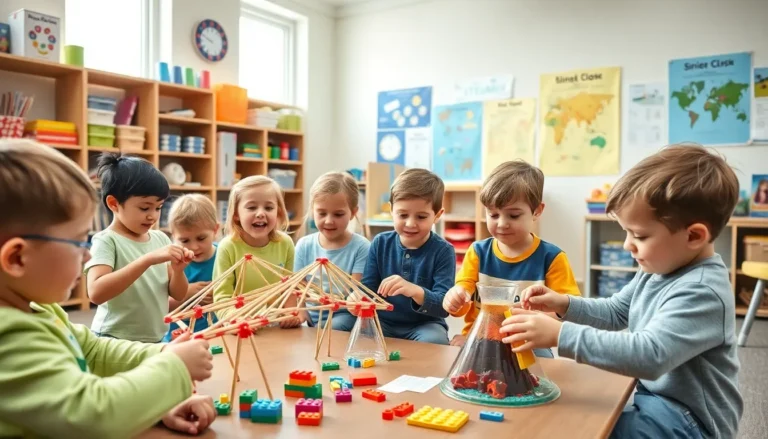Table of Contents
ToggleWhen it comes to providing a loving home for children in need, the debate between fostering and adopting can feel like choosing between chocolate and vanilla—both are sweet, but each has its own unique flavor. Fostering offers a temporary haven, allowing caregivers to make a difference while the child navigates life’s twists and turns. Adoption, on the other hand, is like finding your forever flavor, creating a lifelong bond that can warm the heart like a cozy blanket on a chilly day.
Overview of Fostering and Adopting
Fostering provides a temporary home for children during difficult periods. Caregivers offer stability while the child’s family works on reunification. This arrangement typically lasts from a few days to several months, depending on individual circumstances. Foster parents play a crucial role in nurturing and supporting children in crisis.
Adopting means creating a permanent family bond with a child. This legal process involves a commitment to raise the child as one’s own. Adoption can happen through various pathways, such as public agencies, private adoptions, or international adoptions. Adoptive parents often experience a deep connection and responsibility, offering love and care that lasts a lifetime.
Both fostering and adopting contribute significantly to a child’s well-being. Foster care offers immediate assistance, while adoption provides long-term security and family stability. Each option requires a distinct mindset, emphasizing compassion and dedication.
Legally, fostering allows for the possibility of reunification with biological families, whereas adoption assures that the child remains with their adoptive family forever. Prospective foster parents often undergo training to prepare for the challenges of caring for children in trauma. In contrast, individuals considering adoption focus on building a family and creating lasting memories.
Understanding these differences aids potential caregivers when deciding the path that resonates with their goals and capacities. Whether one chooses fostering or adopting, both paths play essential roles in safeguarding children’s futures.
Key Differences Between Fostering and Adopting
Fostering and adopting serve distinct purposes within child welfare. Understanding these differences aids potential caregivers in making informed choices.
Legal Aspects
Fostering arrangements are usually temporary, with plans allowing the possibility of reunification with biological families. Legally, foster parents act as caregivers, retaining no permanent rights to the child. In contrast, adoption creates a lasting legal bond. Adoptive parents gain full parental rights and responsibilities, treating the child as their own. Various methods exist for adoption, such as public and private agencies, ensuring legal permanence once finalized. Regulations surrounding these processes can vary significantly by state, making it crucial for prospective caregivers to research local laws.
Emotional Considerations
Fostering can be emotionally challenging due to its temporary nature. Foster parents often face the heartache of saying goodbye when children reunite with their families. Caring for children in crisis results in deep emotional connections, yet these can be difficult to navigate. Adoption fosters a different emotional landscape. Committing to raising a child permanently builds a lifelong relationship, promoting stability and security. Adoptive parents often experience joy and fulfillment as they witness their child’s growth. Both paths demand emotional resilience, yet they involve different emotional journeys and outcomes.
Benefits of Fostering
Fostering provides significant advantages for children and caregivers alike. Short-term arrangements and flexibility stand out as key benefits of this option.
Short-Term Support
Fostering offers immediate assistance to children facing crises. Placement can last from a few days to several months, allowing families time to work toward reunification. Children gain access to a nurturing environment during their most vulnerable moments. Foster parents play a vital role by providing stability and consistent care to help children cope with trauma. This support can be crucial for children’s emotional healing. Immediate needs for safety and well-being become a priority, allowing caregivers to address challenges while keeping children’s best interests in mind.
Flexibility
Fostering allows for adaptable caregiving based on individual circumstances. Caregivers can tailor their approach to meet the unique needs of each child. This flexibility helps accommodate different family dynamics and situations. A foster parent may choose short placements or engage in longer commitments depending on their capacity and the child’s requirements. Legalities surrounding fostering do not create permanent ties, making it easier for caregivers to adjust as necessary. This ability to provide temporary care benefits families striving towards reunification without the permanence that comes with adoption.
Benefits of Adopting
Adoption provides several significant benefits, particularly in establishing a secure and loving environment for children. Families created through adoption can share a strong commitment and connection that enriches everyone involved.
Permanent Family
Adoption forms a lasting family unit. Children receive the stability of knowing they belong to a permanent family. Adoptive parents gain full legal rights, ensuring their relationship with the child remains secure over time. Legal guardianship allows parents to make crucial decisions regarding education, healthcare, and more. The emotional bond and commitment that develop contribute to a nurturing and supportive atmosphere. Secure family structures enhance children’s sense of identity and belonging, allowing them to thrive emotionally and socially.
Emotional Stability
Adoption fosters emotional stability. Children find comfort in knowing they are part of a permanent family. This security greatly reduces feelings of uncertainty or abandonment commonly experienced in temporary settings. Consistent support from adoptive parents promotes healthy emotional development. Children adapt more easily, leading to improved self-esteem and behavior. Positive parent-child relationships contribute to resilience as children navigate life’s challenges. The emotional understanding and love provided by adoptive families play a crucial role in establishing a foundation for a successful future.
Conclusion
Choosing between fostering and adopting is a significant decision that impacts both the caregiver and the child. Each path offers unique rewards and challenges, catering to different needs within the child welfare system.
Fostering provides immediate support and flexibility for children in crisis, while adoption establishes a permanent family bond that nurtures long-term emotional stability. Understanding these distinctions empowers prospective caregivers to make informed choices that align with their desires and capabilities.
Ultimately, both fostering and adopting play vital roles in shaping brighter futures for children in need, ensuring they receive the love and care essential for their development.







